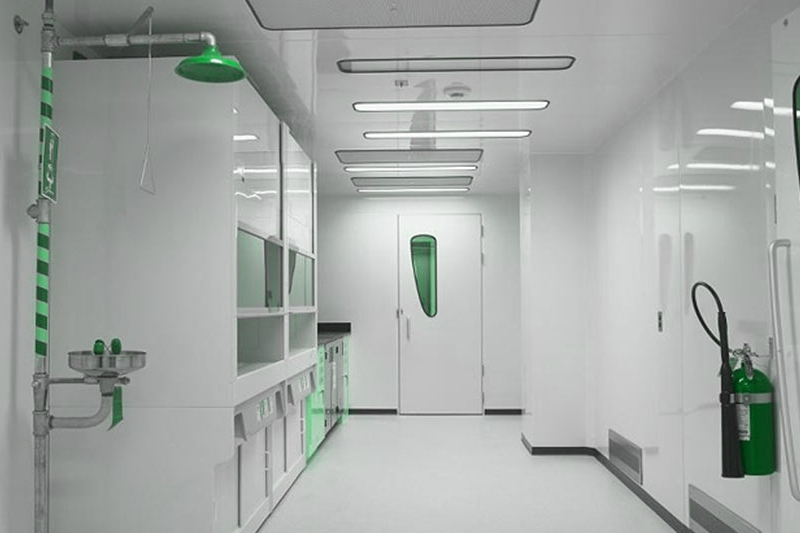What Is Differential Pressure?
When a cleanroom door is opened, impurities can find their way in, causing a reduction in pressure. Conversely, when the pressure within a cleanroom is too high, energy is wasted.
Temperature, humidity, airflow and pressure are all cleanroom parameters that have to be well managed. Pressure is most critical and a key parameter; for instance, when pressure is combined effectively with the other two parameters, cleanrooms function properly.
Computed pressure deviation between two points gives the differential pressure; for example, if the pressure at point A is 200psi and point B is 100psi, the differential pressure is 100psi (200psi-100psi). Differential pressure is critical, as tiny pressure differences can have a huge effect on cleanrooms, as well as manufacturing and HVAC (Heating, Ventilation and Air-conditioning) laboratories. Differential pressure ensures less clean areas within a cleanroom don’t spread contamination to cleaner areas.
Cleanroom operational safety is monitored and improved by measuring air flow velocity/pressure. To achieve pressurisation control will depend on differential pressure control and airflow tracking. Pressurisation control of a cleanroom is mandatory to confirm and maintain cleanroom parameters. Cleanrooms require surrounding areas be positively pressurised to create buffer zones and reduce accidental contamination.
Pressure And The Cleanroom
A cleanroom system is akin to having a mini-building within a larger building. A cleanroom has its own HVAC system, flooring, lighting and differential pressure. The exterior wall of a building should never be used as a cleanroom wall. Also, entry or exit doors should never be the same points for a cleanroom’s interior, because of wind pressure. The implication of a 30 mile per hour wind is a wind pressure of .47 ‘‘w.g. (116.2 Pa). Subsequently, an open door will cause IAQ (Inside Air Quality) problems.
Room pressurisation is a necessity to ensure product integrity. Opening an average sized single width door increases leakage area by 20 square feet or more on average. The implication is a disruption with an appreciable, differential static pressure value. To create a balance, there will need to be an excessive amount of differential airflow.
Measurement Of Differential Pressure
A visual indicator gauge is deployed to compute differential pressure. It is designed to compute and read a differential between two pressure points within a process environment. The gauge is connected to pressure monitored points from two inlet ports. If the gauge isn’t deployed, a control system or operator would need to manually monitor two separate gauges before disclosing their differential readings. This would be a cumbersome process.
We are cleanroom experts and market leaders who offer the DE21 transmitter, which observes and verifies the slightest differential pressure in cleanrooms.
The DE21 is a 2-wire DIN capturing, computing and reading device. It comes with capacity measuring cells to cover diverse low-pressure range areas, combined with a high overpressure guard feature. DE21 instruments provide lengthy, drift-free operations and high precision stability, since no signal broadcast is needed. DE21s are mainly deployed in laboratories, industrial furnaces, filters, blowers and packaging machines.
Key DE21 Features
- Selectable units Pa, mbar, inWC and kPa through a DIP Switch
- Comes with a high guard pressure protection
- Accurate measurement with lowest gauge feature, which can determine differential pressure of non-corrosive and restrictive gaseous exchange
- Long-term stable capacitor sensor element and a high precision feature
- Four-character LCD screen on the front, displaying differential pressure within pressure areas
DE21 supports the following:
- Flow measurement
- Filter monitoring
- Low pressure measurement to support comfort control and automation
DE21 Functionality
The DE21 instrument provides excellent sensor stability and repeatability. This is possible with the presence of an ultra-thin single crystal diaphragm (patented silicon-on-glass technology feature).
Mechanical degradation won’t occur in the long run, because the silicon diaphragm sensor isn’t manufactured with organics or glue. Notably, it’s been proven that organics contribute to a drift or unwanted degradation.
DE21 applications
- Helps in monitoring cleanrooms and laboratories
- Supports filters, fans and packing machines
- Supports the pharmaceutical industry
Testo 521-3 Device For Differential Pressure
The Testo 521-3 is a computing device for differential pressure in cleanrooms. With high level precision and clear data information, its integrated temperature-compensated sensor reads measurements to an accuracy of up to ± 0.5 Pa. There is a wide range of units to choose against pressure measurement, which include: mbar, bar, hPa, Pa, kPa, mmH2O, inH2O, psi and torr.
Features
- The Testo 521-3 has a high computable capability range
- It records the smallest pressure differences, effortlessly
- It can fulfill differential pressure readings for flue inspections or cleanroom use, due to its resolution capabilities
- It features an integrated differential pressure sensor, which has a 0.5% Pa accuracy
- It has calculation attributes for velocity and volume flow, via a pilot tube
- It has automatic recognition functions for all connected probes
- It has a RS232 interface
- It features two probe inputs for additional temperature and pressure
- It has a battery recharging instrument and a mains connection
- It features two probe inputs for additional temperature and pressure
- It features timed mean calculation and also has a multi-point
- Rate is two times in a second, but four times for fast readings
- It has a point matrix, seven segment display and LCD display
- Has a memory of 100 kB (corresponds to approximately 25000 readings)
- Has an overload of 50 hPa
- Has a direct zeroing feature of display values from pressure probes
- Its integrated pressure sensor reads flow velocities of +1 to +20 m/s











